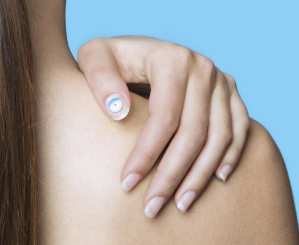Share This
Related Posts
Tags
2018 Wearable Tech
By Anca Gagiuc on Feb 22, 2018 in Technology
At the beginning there were fitness wearables. They slowly transgressed into fashionable wearables and now can be seen in many industries. These days, the tiny devices, once strapped around the wrist, can be found all over one’s body, including on your fingernails.
“We’re seeing lots of not obvious usage scenarios, but once you start to really think about it, it makes perfect sense,” Brian Blau, research vice president for personal technologies at market research firm Gartner, said in an interview from CES.
Here’s a list with some of the most interesting ones out there:
-
- L’Oréal UV Sense

- L’Oréal UV Sense
Among the smallest wearables out there, L’Oréal’s UV Sense is a UV sensor that sticks to your fingernail. It comes with replaceable adhesives, but one can easily stick it to other items, like your watch or sunglasses. Thanks to its NFC feature, in order to access the data it collects, scanning it with the phone is all that’s needed. As you probably guessed, it helps people track how much time people spend in the sun without being overbearing.
UV Sense will determine how long you’ve been out in the sun and once synced with your app, displays a score that shows if you’ve spent too much time under the sun’s powerful rays. Because everyone can handle different amounts of sun, the app will ask some initial questions about your skintone to set a baseline. In addition, it can also recommend products based off your skin score.
- LIZN Hearpieces
Another medical aid presented at CES comes from Danish company LIZN. By mixing advanced hearing aid technology and cell phone components, the company built a product worthy to be named a CES Innovation Awards Honoree this year in Las Vegas. The earbuds, equipped with Bluetooth compatibility (great for listening to music and for taking calls) can do more than just that—they can help those with hearing dysfunctionalities.
LIZN hearpieces consist of two directional microphones (each) and internal software with the ability to isolate the background noise, so that you can easily hear the person in front of you. You can switch between headphone mode and hearing enhancement mode by simply tapping a button on the buds. Moreover, the little gizmo pair provides an open fitting, which means there is no occlusion effect, thus making the sound of your voice natural. The hearpieces, already available for preorder at $149, come in three colors—ruby red, caffe latte and anthracite gray.
- Coros Omni
A basic, but solid cycling helmet is somewhere around $100, for double the amount, the team at Coros Omni offer a kind that’s unlike anything released so far in the bicycle world. The gadget comes equipped with Coros™ Bone Conduction Technology that enables the helmet to connect to your music, phone and loved ones, without earbuds or wires for a safer ride. Specifically, the helmet has two-way audio for music, calls and communications, voice navigation and data. For cyclists, especially in urban areas, is super important to keep the ears open and pay attention to the ambient. To serve this purpose, the Omni helmet keeps the user’s ears are unimpeded through the bone conduction, which bypasses the eardrums. Sound waves are converted into vibrations and delivered through the users’ upper cheekbones. The microphone is made of silicon and has improved call and wind resistance quality.
A super cool and useful feature is the built-in day/night LED safety illumination, which helps provide maximum visibility, regardless if it’s day or night. At dusk, the LED illumination feature activates automatically via a built-in light sensor, otherwise it can be activated via the handlebar mounted smart remote. This brings us to another cool thing the helmet has—a smart remote for hands-free audio control for volume, track forward, pause/play, calls.
A feature that I especially like is the built-in impact G-Sensor emergency alert system—the emergency contact is set up and stored in the Coros smartphone app (iOS, Android). Designed to activate at an impact force of 1G or more, Omni will send an SMS with the GPS location to the designated emergency contact. Of course, through its app the user manages the ride details, routes, voice navigation and GPS data; moreover, it connects and syncs the ride data with popular ones like Strava and MapMyRide.
The new version weighs only 340 grams and breathes through 18 vents. The 700mAh battery will keep the helmet going for about 8 hours. If you want it, know it costs $200 and its campaign on Indiegogo is successful, having raised more than double the amount they had asked for.
- Orbi Prime
Another Indiegogo success, Orbi Prime enables the creation of stunning 360º videos and images, marking the first 360° video recording eyewear. To create 360° videos and images, the gadget has four 1080p cameras and some powerful electronic image stabilization, making it able to support 4K UHD video at 30 FPS for up to 60 minutes.
The goggles have a mobile (iOS, Android) app where videos are stitched automatically, as well as a desktop (MacOS, Windows) app with extended stitching and video editing functionality. Specs-wise, the 0.24-pound device is made of polycarbonate and aluminum and hides inside the frame a new generation image processing SoC, a wireless module, flash memory, inertial measurement unit, a 1,230mAh Li-Pol battery, and micro SDXC of up to 128 GB of storage. If you want it, it can be yours for $399 and shipping starts in August.
